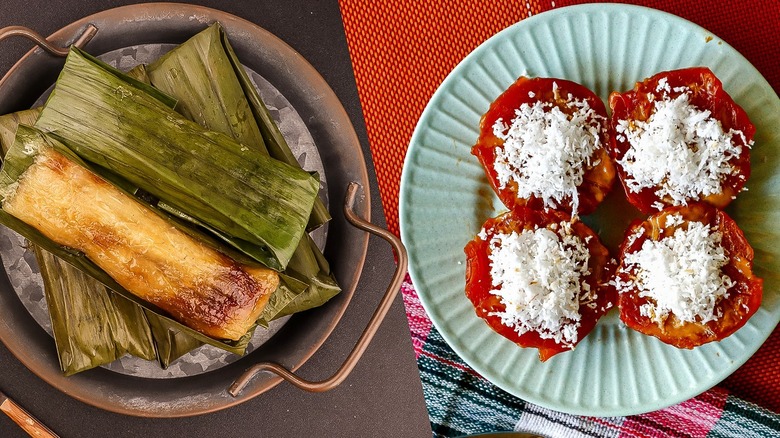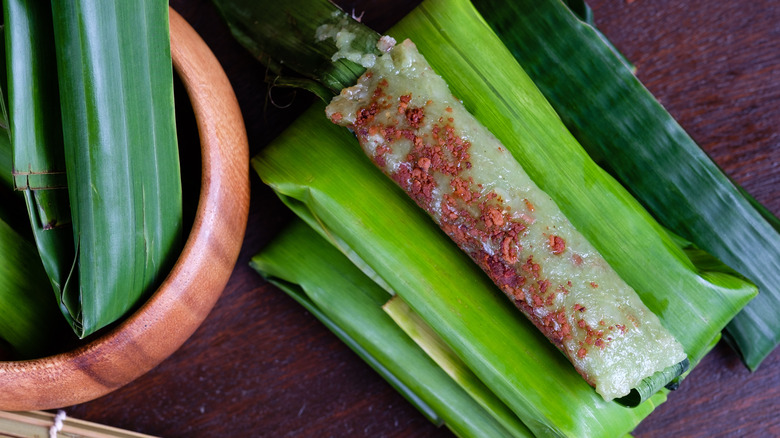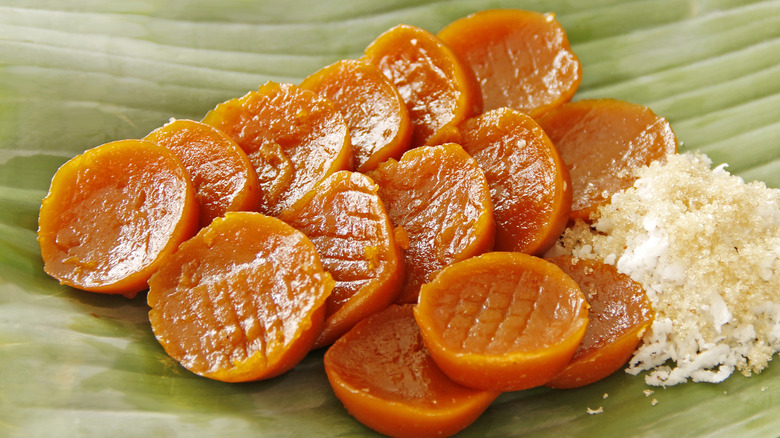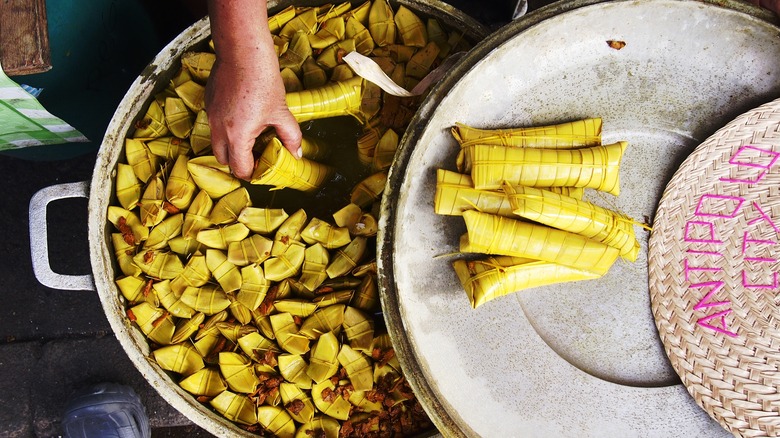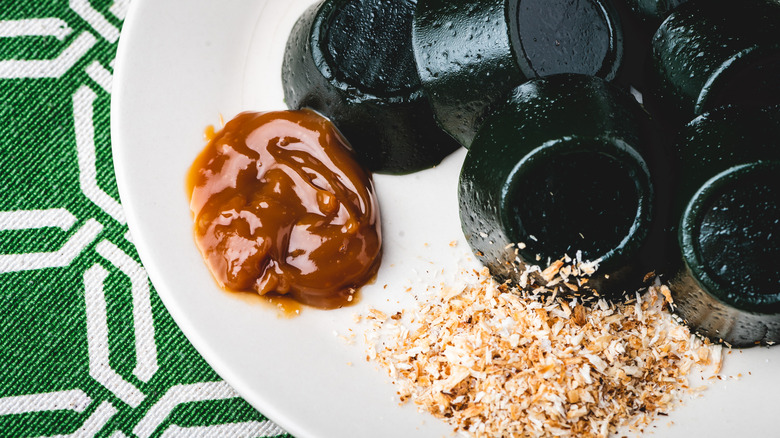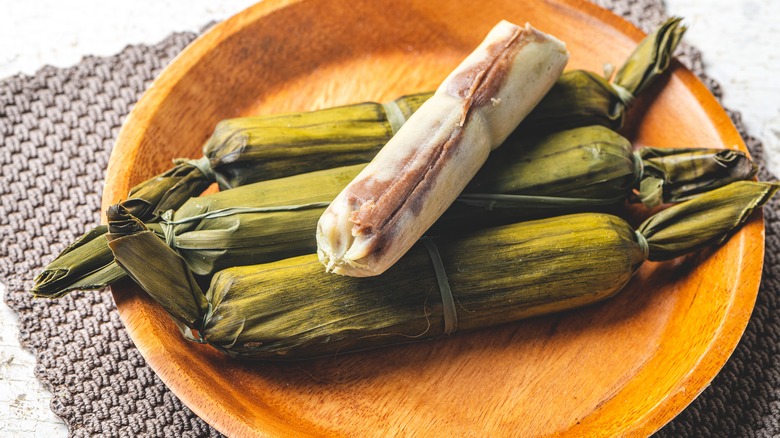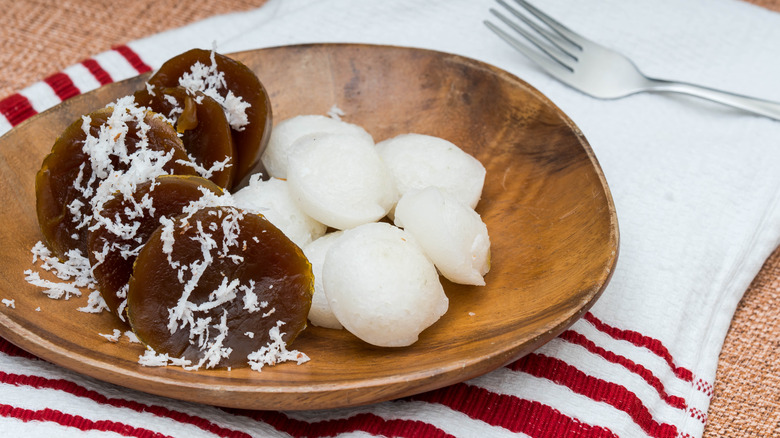Suman Vs Kutsinta: What's The Difference Between These Filipino Rice Cakes?
There are as many as 15 different kinds of Filipino rice cakes or kakanin available — and that's not counting the various interpretations that different provinces in the Philippines would have for each type. Getting to try all of them can be daunting, not the least because kakanin is very filling. It's generally made with glutinous rice and coconut milk, although some varieties are made with cassava. Trying them all is a delicious challenge, however — one that'll open your eyes to the incredible versatility of these basic ingredients and how creative people can be with food.
A good starting point would be two of the most popular types of kakanin — suman and kutsinta. Both have the same main ingredients, yet they could not look any more different. Often rolled like a thick cigar, at times lightly flattened at the edges, and then wrapped tightly in either palm or banana leaves, suman's consistency shows the rice grains more clearly than kutsinta. Kutsinta, on the other hand, has a jelly-like texture, although instead of disintegrating like regular jelly, it presents a pleasant chewiness when you bite into it.
Both are widely available in the Philippines and sold by ambulant vendors, entrepreneurial home cooks, and restaurants. They're also frequently served during gatherings and special occasions. Beyond their mild sweetness, which comes courtesy of the coconut milk, the chewy, sticky texture of these rice cakes also symbolizes to the locals the unity that comes from having strong social bonds.
What is suman?
You will find a local version of suman wherever you go in the Philippines. This popular rice cake is made by cooking glutinous rice in coconut milk with sugar and salt. Once the grains are par-cooked, the rice is left to set for a bit before it is scooped and placed on top of rectangular wrappers cut from either palm or banana leaves. It gets rolled tightly into a log, closed with twine, and put in a steamer for around an hour. Sellers will also flavor suman with brown sugar, peanuts, and chocolate to give it a more pronounced taste and color. It is often topped with toasted coconut milk curds and served with coconut caramel as a dip.
Suman were made in the Philippines long before the island nation was colonized by Spain. The Italian historian Antonio Pigafetta, who served as the chronicler of Ferdinand Magellan's 16th-century exploration to reach the Spice Islands, had noted in his journals how Spanish visitors in the Palawan province were served delicacies "resembling sugar loaves" wrapped in banana leaves.
Suman is easy to make with accessible ingredients. Amy and Romy Dorotan, the Filipino chefs and restaurateurs behind Purple Yam, championed its simplicity in their book "Memories of Philippine Kitchens," describing it as "the most primitive and is prepared the most simply, without the soaking, grinding, and leavening used for [other kakanin types like] bibingka and puto."
What is kutsinta?
Kutsinta is a variety of the kakanin named puto, which is also a steamed rice cake. Its name is believed to come from the Hokkien term "kueh tsin tao," meaning "bite-sized snack" or "dessert." However, there's another theory that kutsinta was named after a now-obsolete kitchen tool that originally gave it the shape of a flattened cupcake. Today, molds are used to give this rice cake its form.
Powder made from grinding annatto seeds is mixed with the glutinous rice to give kutsinta its signature red-orange hue. Annatto seeds are commonly used to add a natural vibrant color to food, especially sauces. Recently, home cooks discovered how adding blackstrap molasses turns the rice cake black, creating another interesting-looking treat. However, since blackstrap molasses has a much lower sugar content and has a bitter and salty taste, it also changes kutsinta's regular flavor. From delicately sweet, it becomes richer with the additional layers of mild saltiness and bitterness and a smoky undertone.
Kutsinta is typically served with a topping of grated coconut. With its black variant, some prefer to serve it with toasted grated coconut and yema — a candy-like version of dulce de leche — to balance the saltiness and bitterness.
Part of suman's flavor and aroma comes from its wrapper
Native leaves are used as suman wrappers for more than decorative purposes or practicality. With the kakanin encased in either banana or palm leaves as it gets steamed, the heat causes the leaf to impart its lightly floral scent to the rice grains.
This aroma becomes stronger when suman is grilled instead of steamed. This is how the suman variant named tupig is cooked. The leaves get toasted enough that crisped bits get stuck to the rice, adding a little crispy texture to the edges, along with a slightly bitter, smoky taste. The inside, however, remains moist, chewy, and lightly sweet.
For a more decadent treat, some folks fry an unwrapped steamed suman in medium heat, giving it a crunchy crust. This can be served with slices of ripe mango, similar to the Thai dessert mango sticky rice. The fruit's light acidity balances the richness of the rice cake. Coconut jam or coconut caramel is also drizzled on top for another layer of flavor.
Kutsinta's jelly-like texture comes from lye water
Although kutsinta is a variant of puto since it's cooked in a similar manner and with the same main ingredients, it comes out sticky and jelly-like, unlike the latter's fluffy and chewy texture. This is due to the addition of lye water, an alkaline solution made from dissolving potassium carbonate in water. This food-grade liquid is available commercially and used in numerous Chinese dishes. Adding the right amount of lye water neutralizes the acidity in the food and adds a pleasant elasticity and tenderness to the starch in noodle dishes and baked goods.
The same effect happens to kutsinta, hence its springiness. In addition to the annatto powder, lye water adds a yellow tint to the rice cake, resulting in kutsinta's eye-catching color. However, cooking with this solution must be done with care since it is corrosive to bare skin and dangerous to taste raw. Following the recipe exactly is also important since too much lye water can make food taste bitter.
There's also a suman variant called suman sa lihiya that is cooked with lye water, although it's more for adding a light yellow coloring rather than changing its texture.
Suman is also treated as breakfast fare
Since kakanin is so filling, Filipinos treat it as a snack more than as a dessert. In some of the Philippines' southern provinces, suman is enjoyed as a breakfast food. A specific variant is called budbod kabog, made with ground millet seeds that give the suman a more buttery texture. Budbod is sold in the painitan — small coffee shops in the public markets of the Visayan region — with locals and tourists stopping by in the morning to eat them with a cup of coffee or sikwate (hot chocolate).
Another popular type of suman is moron (emphasis on the second syllable), which combines two flavors in one. Glutinous rice flour is divided into two batches so one gets a chocolate flavor added while the other is flavored with coconut milk; some home cooks also use vanilla to add more contrast between the two tastes. Each batch of par-cooked and flavored glutinous rice is sectioned into strips. Each strip is intertwined with a different flavored one, and the resulting braid is wrapped in banana leaves and then steamed. This suman is sweeter than the usual type, with a marbled effect in its coloring. It's perfect when enjoyed with a cup of hot chocolate.
Kutsinta is often paired with puto
The differences in texture and color between kutsinta and puto make the two a popular combo. Eating their bite-sized portions one after another is easy since they're both mildly sweet. Plus, despite being starchy treats, the variations in their consistency keep the palate from getting sated quickly. Their pairing is even better when the kutsinta's grated coconut topping is mixed with sugar and toasted sesame seeds, while strips of cheese garnish the puto.
These rice cakes are also great when served beside savory dishes. Puto is more known for this since its fluffy texture makes it a perfect alternative to steamed rice; it is famously paired with dinuguan (pork blood stew), one of the most popular Filipino dishes. With kutsinta, it is a great accompaniment to pancit canton, a noodle dish cooked with meat and vegetables. Aside from providing a sweet counterpoint to the savory noodles, both food items create an appetizing medley of colors on the plate.
